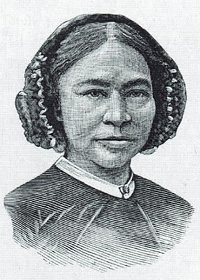Introduction

Born: February 7, 1817, North Hampton, Pennsylvania.
Died: March 4, 1893, Newburg, Gainsville, New York.
Buried: Woodlawn Cemetery, New Windsor, New York.

Born: February 7, 1817, North Hampton, Pennsylvania.
Died: March 4, 1893, Newburg, Gainsville, New York.
Buried: Woodlawn Cemetery, New Windsor, New York.
Catherine was the daughter of Simon Cornelius Gilchrist and Elizabeth Wolf.
On November 16, 1841, she married Joseph Pascal Thompson in Williamsport (Pennsylvania?). Joseph was a bishop of the African Methodist Episcopal church, so some sources give Catherine’s name as Mrs. Bishop Thompson.
She was an exceptional woman in many respects—amiable, pious, devout. She was a great organizer, and had wonderful executive ability.
Her greatest delight was in the Sunday school work. She devoted hours of earnest thought and prayer to the most effective means of attracting the youthful mind to the truths of the Scriptures.
In the work she was earnest and persevering, and by her winning manner captivated the hearts of the children, drew them together, and her labors were almost always bountifully rewarded.
In Church society work Mrs. Thompson occupied the highest place among her sister laborers; always willing, always ready, no sacrifice seemed too great for her to make for the good of the cause.
She was long honored as the president of the Sons and Daughters of Conference of her Church (African Methodist Episcopal Zion), and was always active in perfecting plans for its advancement.
The Bible was her book of books, and her familiarity with its contents was as remarkable as her many faculties. Indeed, in depth of learning she ably coped with many of the clergy of her day.
She was a valuable helpmate to her husband, and many long hours found them together discussing intricate scriptural doctrines.
During the dark days of slavery her mind was riveted on the work of allaying the suffering of her unfortunate fellow-creatures. Many clever schemes she devised in effecting their escape from bondage. The incidents she and the bishop have related have been most thrilling in detail.
The last official place Mrs. Thompson held was as treasurer of the Ladies’ Home and Foreign Missionary Society of the connection.
Hood, pp. 216–18